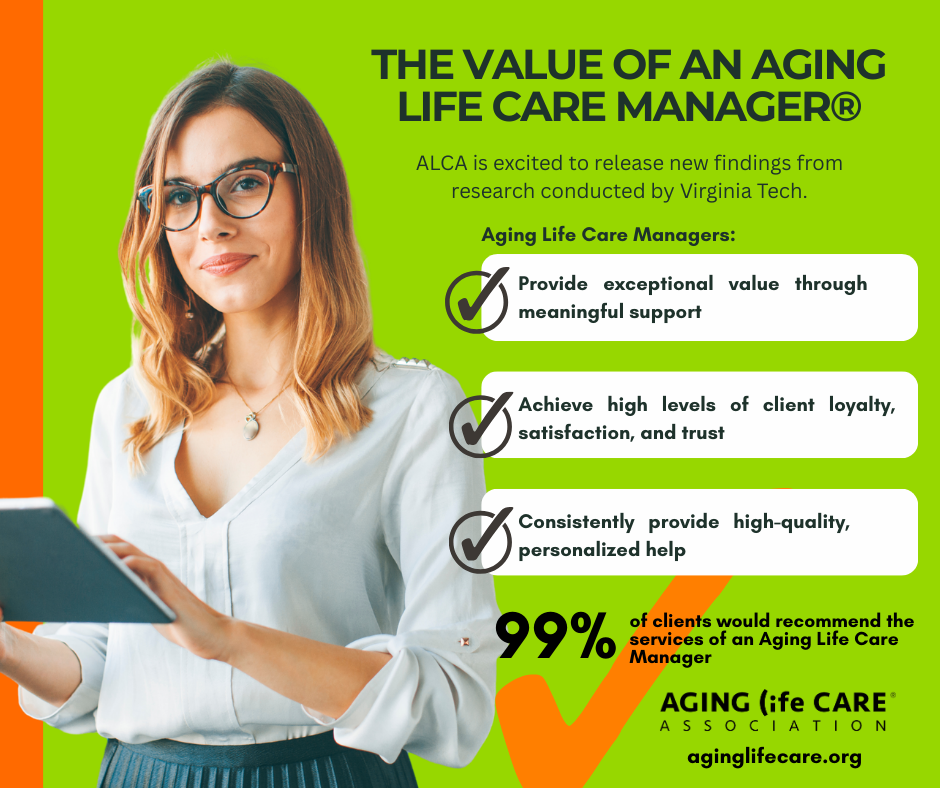New research from Virginia Tech confirms what many families already know: Aging Life Care Managers deliver exceptional value, expert guidance, and peace of mind for older adults and their families.

Who are Aging Life Care Managers®?
Aging Life Care Managers are professionals trained in aging and disability care. They help families manage changing health conditions, coordinate complex services, and navigate difficult transitions. But their impact goes far beyond logistics, they offer trusted advocacy, emotional reassurance, and compassionate support during life’s most uncertain times.
The Research Study: Real Voices, Real Results
To assess their impact, researchers conducted in-depth interviews and followed up with a national survey of current and former clients and families. The results offer a compelling portrait of the Aging Life Care Manager’s role: a knowledgeable partner who reduces stress, builds trust, and enhances care quality, from initial crisis to end-of-life planning.
At the core of their work is a strong ethical foundation. Aging Life Care Managers advocate with integrity, uphold confidentiality, and place the values and wishes of the client at the center of every decision. That professionalism is what builds the trust needed for deep connection and meaningful, person-centered care.
There Every Step of the Way

Clients Overwhelmingly Recommend Aging Life Care Managers®
Families describe Aging Life Care Managers as ethical, respectful, and deeply trustworthy professionals who provide high-quality, personalized care. Their ability to bring clarity in chaos and calm in crisis has earned them not just gratitude but lasting loyalty.
Survey findings:
- 99% would recommend an Aging Life Care Manager
- 97% felt grateful for the support
- 93% said the value outweighed the cost

Client voices on Aging Life Care™ services:
“It allows me to sleep at night.”
“It’s worth every cent.”
“If we’re lucky enough, we’ll all get old – people should have access to this.”
Clients didn’t just appreciate Aging Life Care Managers; they relied on them. Whether stepping in during emergencies, managing transitions, or ensuring the client’s voice was honored, Aging Life Care Managers made a lasting impact.
Expertise That Families Trust
For most families, especially long-distance caregivers, Aging Life Care Managers served as lifelines. Their reliability, responsiveness, and deep knowledge of local resources gave families peace of mind, no matter the distance.
Survey findings:
- 97% said Aging Life Care Managers helped mediate family dynamics
- 97% noted they developed effective care plans
- 96% reported knowledge of local providers
- 95% confirmed privacy was protected
- 94% agreed Aging Life Care Managers promoted objective, balanced decision-making
Client reflections on their Aging Life Care Manager:
“Anything we needed to know, she could intervene.”
“She’s an extension of me.”
“I felt confident in her skills and in her commitment.”
With a unique blend of clinical expertise and heartfelt dedication, Aging Life Care Managers helped families make informed decisions and feel supported through every step.
Holistic, Personalized Support
What sets Aging Life Care Managers apart is their commitment to understanding each client as a whole person, not just their needs, but their values, relationships, and preferences. Aging Life Care Managers were also instrumental in supporting families emotionally, helping them navigate grief, guilt, and difficult decisions with compassion and clarity.
Survey findings:
- 95% said their Aging Life Care Manager understood emotional challenges
- 91% found them responsive in crises
- 87% received help managing care transitions
Clients shared about their Aging Life Care Managers:
“She hears us and applies it to the situation.”
“We could call her at the drop of a hat.”
“I felt tired and hopeless – care managers bring hope.”
Improved Quality of Life
Families consistently reported better outcomes, reduced stress, and less isolation thanks to Aging Life Care Manager support. Their role often extended beyond the client’s passing, offering continuity, helping families honor their loved one, and bringing closure with care.
Survey findings:
- 97% said their Aging Life Care Manager brought peace of mind
- 92% felt future needs were anticipated
- 87% said the Aging Life Care Manager helped the client live well
- 82% noted a reduction in isolation
Client stories:
“The Aging Life Care Manager helped her live well at the end of her life.”
“[My family member] was wrapped in a cocoon of services and loved.”
“Even after her passing, the Aging Life Care Manager arranged a celebration.”
The research shows, from start to finish, Aging Life Care Managers provided more than care; they offered presence, compassion, and unwavering support.
Conclusion: More Than Services, True Partnership in Care
The Virginia Tech study offers powerful evidence: Aging Life Care Managers are not just service providers, they are partners in care. They bring clarity to complexity, advocate with integrity, and support families through life’s most vulnerable moments. For families facing the challenges of aging, an Aging Life Care Manager is not just helpful, they are essential.
If you’re navigating the challenges of aging or caregiving, consider reaching out to an Aging Life Care Manager. Your family’s peace of mind could start with a single conversation.
Want to find an Aging Life Care Manager near you? Visit www.aginglifecare.org to learn more and connect with a professional in your area.

SOURCE: Shealy, E. C., Teaster, P. B., Sands, L., & Gray, J. (2025, April 23). An examination of the Aging Life Care Association. Part two: Qualitative client interviews and client survey. Aging Life Care Association 41st Annual Conference, Boston, MA.